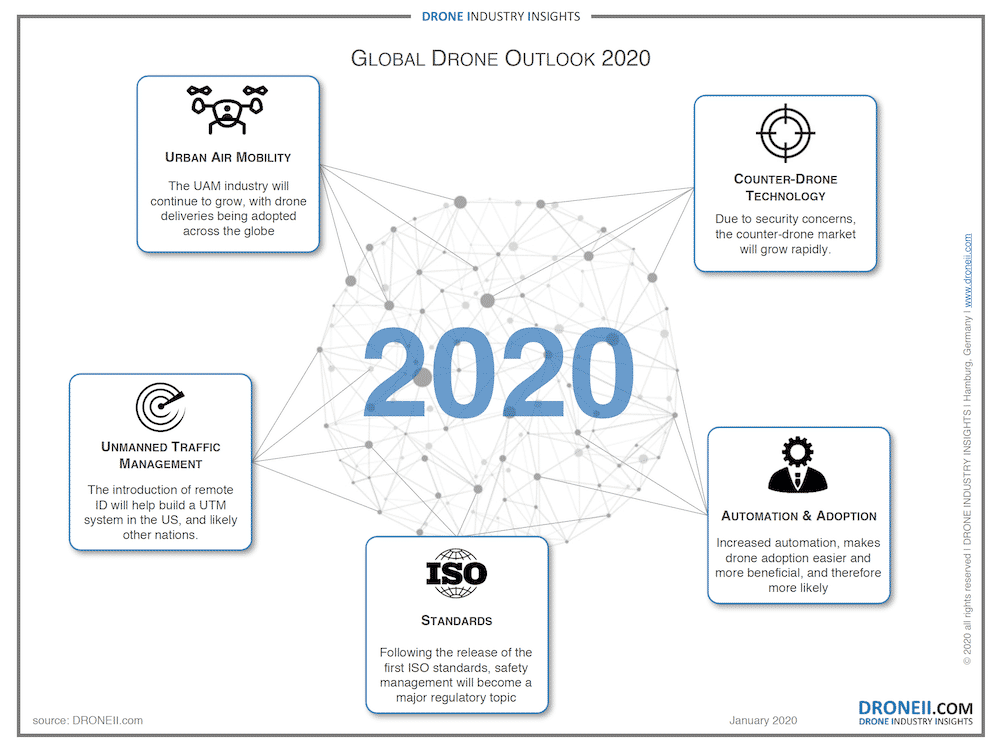
As both the new year and new decade begin, new trends, challenges and opportunities for the commercial drone industry lay ahead. Drone Industry Insights, the leading source for business intelligence in the field of commercial drones, have laid out the key trends that we should be looking out for this year.
Counter Drone Technology
Due to a series of highly publicised incidents in both 2018 and 2019, the counter-drone market took off and grew rapidly last year. The number of counter drone solutions almost doubled, and nations began to formulate counter-drone strategies and the variety of solutions available continued to grow. Within 2020, this market is expected to continue to grow and mature as we will see more solutions, more money, more contracts, and more advanced technology flooding the counter drone industry.
The question for the year will be, will more advanced counter-drone technology remain limited to government actors, the military and critical infrastructure (such as airports), or will it become a standard across public and private spaces?
Urban Air Mobility (UAM)
Since the beginning of the commercial drone industry, Urban Air Mobility (UAM) has been a big topic. Companies began to develop passenger drone concepts early on, however last year UAM was a particularly prominent topic, as drone deliveries began to take off in Australia, the United States, Ghana and elsewhere. Companies are developing aerial delivery solutions for both urban and rural spaces, delivering objects varying from medicine to food, retail packages and industrial materials.
In 2020, expect further developments in the drone delivery industry, whilst passengers drones are likely to be a slow burner due to the much higher regulatory and technological aspects that they face. More specifically, companies developing passenger drones, (also known as flying cars, air taxis and eVTOLs) will need more time and a significant amount of funding to get certified. This process has been estimated to cost around $1 billion per platform.
Whilst regulation is not the biggest issue within the drone industry, access to a combination of reliable technology, a nearby expert network and funding (as many small tech companies in the drone delivery sector are underfinanced) is currently the biggest challenge.
Furthermore, there are also big regional differences in terms of drone delivery activity and overall UAM progress. Whilst Chinese drone delivery service providers already operate frequently even in urban areas, the US is still in its test stage and struggle with high requirements to operate in public environment. The key to getting ahead wont just be in governments issuing special permits, but in the set-up of an approval system which will allow for the scaling of drone deliveries.
Unmanned Traffic Management
The drone industry, more specifically those working in unmanned traffic management (UTM), will prepare for Remote ID standards. Remote ID will introduce the ability of a drone to provide identification information that can be received by other parties.
Within America, the US Federal Aviation Authority (FAA) published a proposed Remote ID rulebook for public comments in December 2019. One highlight is the selection of nine core suppliers like Airmap, Kittyhawk or Unifly, which will be approved by the end of the year to be contracted by the FAA to supply remote ID services for the US airspace.
In Europe, its expected that EASA will publish an opinion about Remote ID and their U-Space initiative in the first quarter of 2020. It will be interesting to see how these proposed rules will differ from the US rules.
Remote ID will avoid the use of ADS-B (Automatic Dependent Surveillance-Broadcast) technology on drones. The FAA is afraid that the high expected drone traffic will negatively affect available ADS-B frequencies, which then will in turn also affect ADS-B capabilities for manned aircraft creating a possible safety risk. All of these developments raise many questions for the year ahead.
Will these remote ID standards also affect the market share of DJI (already affected by the US-China trade war) who have planned to start in 2020 to installing ADS-B receivers in all new drones above 250g? Can all countries follow the EASA timeline that EASA members have to set up a registration procedure?
Adoption & Automation
Meanwhile, adoption of drone technology will continue. As the complexity falls, due to higher automation and workflow integration, more companies will start drone operation or pull outsourced operation in.
Part of the reason for increased and continued adoption is certainly due to automation, both in terms of data processing and execution. Drones often generate large amounts of data – sometimes more than we ca handle. The faster, the more accurate, and the easier the images can be evaluated, the better.
ISO Standards
2019 closed off with the announcement of the first ISO approved drone safety standards in December. This means that in 2020 the set-up of a safety management system will be a major regulatory topic. It also means that the foundation for future rulemaking, standardising and legislating of drone operations has now been laid.
The key challenge in 2020 will lay in the implementation and harmonization with national standard coordinating bodies and the compatibility of these standards with existing drone regulations.
